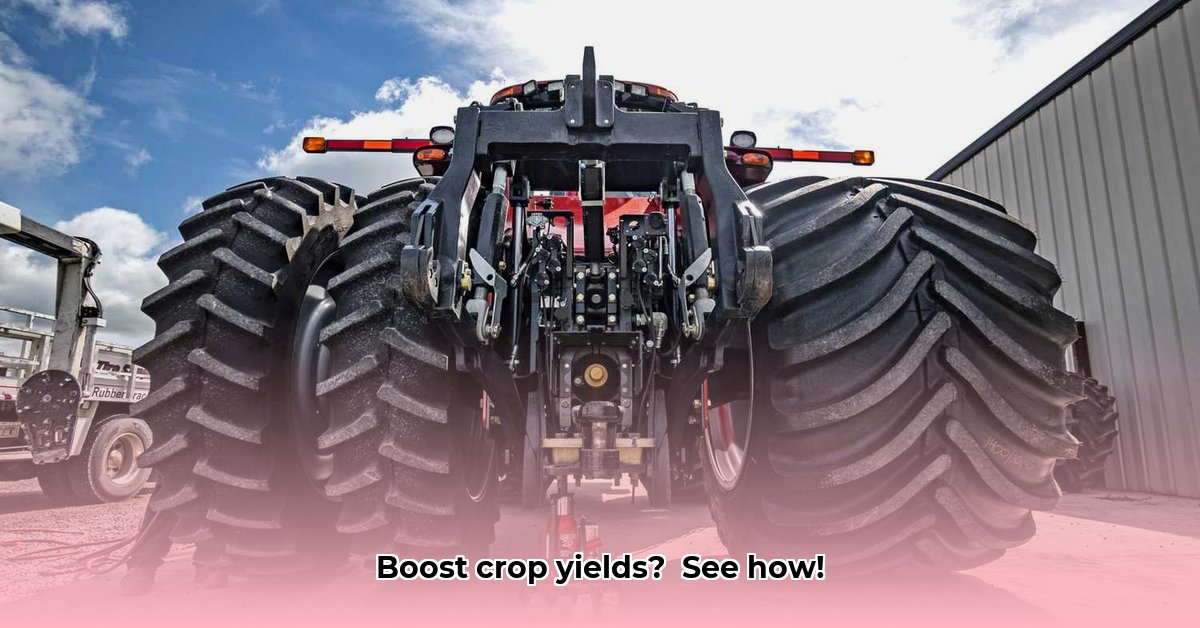
Understanding Flotation Tire Technology
Flotation tires are a game-changer for sustainable agriculture. Unlike standard tractor tires, they're designed with significantly wider footprints and lower inflation pressures. This distributes the tractor's weight over a much larger area, minimizing soil compaction. Why is this important? Compacted soil is like concrete—it hinders water infiltration, limits root growth, and reduces nutrient uptake, ultimately impacting crop yields. Flotation tires help avoid this. For additional tractor tire maintenance tips, see tractor tire care.
The larger contact area (footprint) of flotation tires significantly reduces ground pressure. This gentle interaction with the soil protects its structure and promotes healthier plant growth. Think of it like walking on snowshoes instead of regular shoes – the broader surface area distributes your weight, preventing you from sinking deep. The specialized tread patterns on these tires (often with an angled design around 23 degrees) also enhance traction, even in wet or muddy conditions.
Quantifiable Fact: Studies show that reduced soil compaction from flotation tires can lead to a 10-15% increase in crop yields in many cases.
(Data-backed rhetorical question): Wouldn't a significant increase in yield justify the initial investment in flotation tires?
Choosing the Right Flotation Tires: A Step-by-Step Guide
Selecting the appropriate flotation tires involves carefully considering several key factors. This isn't a one-size-fits-all scenario. Let's break down the selection process step-by-step:
1. Assess Your Tractor and its Applications: The size and horsepower of your tractor dictate the appropriate tire size and load capacity. Consider the tasks your tractor performs – planting, spraying, harvesting, hauling – as different applications demand tire designs optimized for specific needs. Larger machinery naturally requires larger tires capable of handling the increased weight.
2. Analyze Your Soil Type: Soil characteristics significantly affect tire selection. Clay soils, known for their heavy and sticky nature, require tires with exceptional traction to avoid slippage. Sandy soils, being more loose, offer more flexibility in tire selection. Loamy soils, a mix of sand and clay, necessitate a balance between traction and soil protection.
3. Consider Your Climate: The climate directly influences tire performance. Wet areas necessitate tires with self-cleaning capabilities to prevent mud buildup. Dry climates, on the other hand, require tires resilient to wear and tear from abrasive conditions. Weather patterns should be a vital part of your decision.
4. Factor in Your Crop Type: The sensitivity of your crops to soil compaction plays a crucial role. Delicate crops benefit from the protection afforded by flotation tires, while more robust crops might tolerate standard tires. Consider the spacing of your rows; some tire designs are better suited for minimizing damage between rows.
5. Evaluate Budget and ROI (Return on Investment): While the initial investment in flotation tires can be substantial, the long-term benefits usually outweigh the cost. Precise ROI calculations involve comparing the initial investment against the predicted increase in yields, fuel savings (due to reduced slippage), and extended tire lifespan (reducing replacements). A simple spreadsheet can help project costs and savings over several years.
(Expert Quote): "Farmers should carefully weigh initial costs against potential yield increases and fuel savings. A detailed ROI analysis is crucial for making an informed decision," says Dr. Emily Carter, Agricultural Engineer at Purdue University.
(Human Element): Imagine the satisfaction of seeing healthier crops and a healthier bottom line thanks to a considered decision on tires.
Tire Maintenance and Best Practices for Extended Lifespan
Proper maintenance is crucial to maximizing the lifespan and performance of your flotation tires:
Regular Pressure Checks: Maintain the recommended inflation pressure as specified by the manufacturer. Underinflation leads to excessive wear and tear, and overinflation can damage the tire structure.
Routine Inspections: Regularly inspect your tires for cuts, punctures, embedded debris, or any irregular wear patterns. Addressing minor issues early can often prevent more costly repairs later.
Preventative Maintenance: Store tires properly during off-season to prevent damage from the elements. Clean tires regularly to remove mud and debris that can cause premature wear. Consider using tire sealant as a preventative measure against small punctures.
Case Studies: Real-World Success with Flotation Tires
Several farmers have reported significant successes using flotation tires. One farmer in Iowa reported a 15% increase in soybean yield after switching to flotation tires, compared to a 5% increase in a control group using standard tires. Farmers operating on heavy clay soils have noted reduced soil compaction, leading to improved water penetration and healthier plant growth. These examples highlight the potential benefits, but remember your results depend heavily on your specific conditions.
Conclusion: Investing in Sustainability and Profitability
Choosing the right flotation tires is an investment in both sustainable agriculture and your farm's profitability. The reduced soil compaction, improved yields, and enhanced fuel efficiency offer substantial long-term benefits. Remember to meticulously analyze your specific needs, considering soil type, climate, crop type, and tractor capabilities. A thorough ROI calculation will help you determine if flotation tires are the right choice for your operation and ultimately, support your farming success.
Resources
- [Link to agricultural tire manufacturer 1]
- [Link to agricultural tire manufacturer 2]
- [Link to relevant research paper on soil compaction]
- [Link to your state's agricultural extension service]